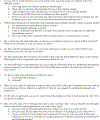Exploring Physiotherapists' Use of Motor Learning Strategies in Gait-Based Interventions for Children with Cerebral Palsy
- PMID: 31154883
- PMCID: PMC6864228
- DOI: 10.1080/01942638.2019.1622623
Exploring Physiotherapists' Use of Motor Learning Strategies in Gait-Based Interventions for Children with Cerebral Palsy
Abstract
Aim: This study investigated physiotherapists' experiences using motor learning strategies (MLS) in gait-based interventions for children with cerebral palsy (CP). The objectives were to explore how child characteristics, physiotherapist decision-making, and treatment approach influenced intentional MLS use.Methods: Semi-structured interviews were conducted with eight physiotherapists who provided gym- and/or Lokomat-based treatment to children with CP. Interviews were analyzed using directed content analysis and a modified constant comparison method.Results: Three themes described their experiences: (1) MLS use is driven by the unique aspects of the child, physiotherapist, and intervention; (2) The use and description of motor learning content varies among physiotherapists; and (3) The Lokomat is "the same but different." Child characteristics were at the forefront of MLS selection in both interventions. The terminology used to describe MLS use varied considerably among therapists. They used similar clinical decision-making in gym- and Lokomat-based interventions.Conclusions: Conscious reflection on the factors affecting MLS use could facilitate related clinical decision-making in physiotherapy interventions for children with CP. Increased awareness of MLS and use of a structured framework for reporting MLS are required to promote intentional MLS use and generate CP-specific evidence-based MLS research.
Keywords: Cerebral palsy; clinical decision-making; motor learning; motor learning strategies; physiotherapy.
Conflict of interest statement
Disclosure statement
No potential conflict of interest was reported by the authors.
Figures
Similar articles
-
Physiotherapists' experiences of physiotherapy interventions in scientific physiotherapy publications focusing on interventions for children with cerebral palsy: a qualitative phenomenographic approach.BMC Pediatr. 2012 Jul 2;12:90. doi: 10.1186/1471-2431-12-90. BMC Pediatr. 2012. PMID: 22747596 Free PMC article.
-
Reliability of the Motor Learning Strategies Rating Instrument in physiotherapy intervention for children with cerebral palsy.Dev Med Child Neurol. 2019 Sep;61(9):1061-1066. doi: 10.1111/dmcn.14177. Epub 2019 Feb 11. Dev Med Child Neurol. 2019. PMID: 30740648 Free PMC article.
-
How physiotherapists supervise to enhance practical skills in dedicated aides of toddlers with cerebral palsy: A qualitative observational study.Physiother Theory Pract. 2019 May;35(5):427-436. doi: 10.1080/09593985.2018.1453003. Epub 2018 Mar 20. Physiother Theory Pract. 2019. PMID: 29558237
-
Multilevel Surgery for Children With Cerebral Palsy: A Meta-analysis.Pediatrics. 2019 Apr;143(4):e20183390. doi: 10.1542/peds.2018-3390. Pediatrics. 2019. PMID: 30918016
-
Active exercise interventions improve gross motor function of ambulant/semi-ambulant children with cerebral palsy: a systematic review.Disabil Rehabil. 2019 May;41(10):1131-1151. doi: 10.1080/09638288.2017.1422035. Epub 2018 Jan 5. Disabil Rehabil. 2019. PMID: 29303007
Cited by
-
Using interactive computer play in physical therapy and occupational therapy clinical practice: an explanatory sequential mixed methods study.Front Med Technol. 2024 Sep 20;6:1381165. doi: 10.3389/fmedt.2024.1381165. eCollection 2024. Front Med Technol. 2024. PMID: 39372965 Free PMC article.
-
Reliability of the Revised Motor Learning Strategies Rating Instrument and Its Role in Describing the Motor Learning Strategy Content of Physiotherapy Sessions in Paediatric Acquired Brain Injury.Physiother Can. 2021 Nov 1;73(4):381-390. doi: 10.3138/ptc-2020-0014. Epub 2021 Oct 20. Physiother Can. 2021. PMID: 34880545 Free PMC article.
-
Exploration of physiotherapists' use of motor control strategies for the treatment of idiopathic toe walking in children: a qualitative study.BMJ Open. 2022 Nov 28;12(11):e062704. doi: 10.1136/bmjopen-2022-062704. BMJ Open. 2022. PMID: 36442904 Free PMC article.
-
Physiotherapy-assisted overground exoskeleton use: mixed methods feasibility study protocol quantifying the user experience, as well as functional, neural, and muscular outcomes in children with mobility impairments.Front Neurosci. 2024 Jul 31;18:1398459. doi: 10.3389/fnins.2024.1398459. eCollection 2024. Front Neurosci. 2024. PMID: 39145294 Free PMC article.
-
Development of a Play-Based Motor Learning Approach (A.MO.GIOCO) in Children with Bilateral Cerebral Palsy: Theoretical Framework and Intervention Methodology.Children (Basel). 2024 Jan 19;11(1):127. doi: 10.3390/children11010127. Children (Basel). 2024. PMID: 38275437 Free PMC article.
References
-
- Beveridge B, Feltracco D, Struyf J, Strauss E, Dang S, Phelan S, … Gibson BE (2015). “You gotta try it all”: Parents’ experiences with robotic gait training for their children with cerebral palsy. Physical & Occupational Therapy in Pediatrics, 35(4), 327–341. doi:10.3109/01942638.2014.990547 - DOI - PubMed
-
- Boeije H (2002). A purposeful approach to the constant comparative method in the analysis of qualitative interviews. Quality and Quantity, 36(4), 391–409.
MeSH terms
Grants and funding
LinkOut - more resources
Full Text Sources
Medical
Miscellaneous


